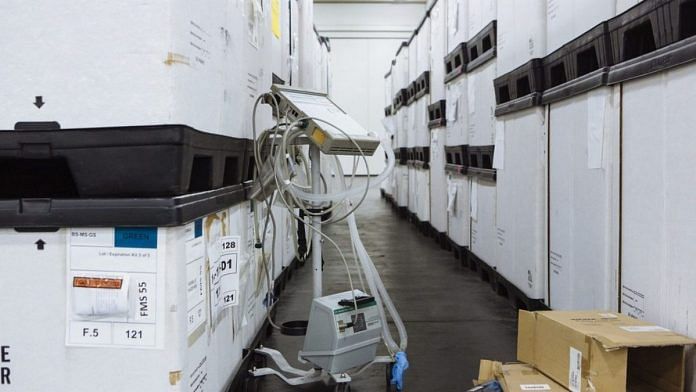New Delhi: India has more than 2,301 positive Covid-19 cases, including 56 dead, but a detailed analysis of the positive cases — especially in the worst-hit states — shows that only a very small percentage of the infections are classified as “critical” with the patients on ventilator support.
A majority of the cases are only “mild”, the data analysis by ThePrint shows.
In the top five most affected states, only eight of the 1,414 Covid-19 positive cases (as of 2 April) — or less than 1 per cent of the total — were on ventilators, the data shows.
According to the data collated for Maharashtra, Kerala, Tamil Nadu, Karnataka and Delhi by the Union Ministry of Health Affairs, only one patient in Delhi, two in Karnataka and five in Maharashtra are on ventilator support. This is just 0.56 per cent of the total cases.
Only those critically ill require ventilators.
According to World Health Organisation (WHO) estimates, based on analysis in China, most patients (80 per cent) experienced mild illness, while “approximately 14 per cent experienced severe disease and five per cent were critically ill”.
It is the critically ill patients who require the support of a ventilator — a device that is connected to the lungs that assists in breathing..
Ventilators are required for Covid-19 patients who develop acute respiratory distress syndrome when the lungs are filled with fluids that make it difficult to breathe.
“A ventilator is used when lungs are filled with fluid. Such patients find it very difficult to be oxygenated in a normal way. The only way to manage is to put the patient on ventilator assistance,” said Judish Raj, an industry veteran and founder of Hyderabad-based Sithara Adept Technologies, which manufactures medical devices.
The additional pressure from the ventilator pumps oxygen into the bloodstream, and takes out carbon dioxide from the lungs.
Until 30 March, the health ministry had revealed that less than 20 patients suffering from Covid-19 infection were on ventilators across the country out of a total of 1,296 cases — which is around 1.54 per cent.
The ministry has not released the collated figure on the total number of patients on ventilators since.
Further, the ministry revealed that it had identified 14,000 ventilators across states.
Also read: No new Covid-19 case in 4 days, Bhilwara could offer lessons in fight against pandemic
State-wise break-up
In Maharashtra, which has the highest number of coronavirus patients, five patients (1.2 per cent) of the 416 need ventilators according to figures accessed on 2 April.
Further, 394 (94 per cent) out of 416 patients showed mild Covid-19 symptoms. Six (1.4 per cent) of its patients are in a serious condition but do not need ventilators and 12 (2.8 per cent) are what the state has described as “semi-serious”.
In Kerala, which has the second highest number of cases, no patient is on ventilator.
In Tamil Nadu, none of the 309 patients are on ventilator. “All those who are under quarantine are responding to treatment and are stable,” said Secretary, Health, Beela Rajesh.
In Delhi, of 293 cases, one patient (0.34 per cent) is on ventilator and five are on oxygen therapy, when external oxygen is provided to a patient.
In Karnataka, two (1.8 per cent) of 110 cases are on ventilator, while one patient has been admitted in the intensive care unit and is undergoing oxygen therapy.
Numbers heartening but too early for relief: Experts
The fear of the unknown is leading to largescale panic and a certain amount of overreaction, said Dr Om Srivastava, infectious disease specialist at Jaslok Hospital, Mumbai.
Rather than just focussing on the number of ventilators, we also need to ask if we have enough trained staff who can run the ventilators, Srivastava said.
While it is true that only 1 per cent of the total infected population requires a ventilator, what the country needs to know right now is how much of the population is actually infected, he said.
“India is not yet in the middle of the curve so we do not yet know how the disease peaks in India. We are six weeks behind the US and two months behind Italy,” he said.
In any case, preparing health infrastructure is a good idea. “The most that you will lose is money and that is okay,” he said.
Dr Sushila Kataria, expert in management of infectious diseases at Medanta Hospital, Gurugram, said it’s too early to be happy about the small number of people on ventilation support.
“The incidents that have come into light in the last 2-3 days across India will lead to a sudden spurt in the number of cases. As the number of infections rise, it will grab more elderly or people with co-morbid conditions and the percentage of patients on ventilator will jump,” Kataria, who played a primary role in treating the group of Italian tourists suffering from Covid-19 infections, said.
Srivastava said age and comorbidity are not the only risk factors that will determine complications. “One needs to make sure that immunity and metabolism are intact so that the body does not react badly to an infection,” said Srivastava, who just discharged a 37-year-old Covid-19 patient from Mumbai who needed to be on ventilator twice.
“Those having uncontrolled diabetes, thyroid, high blood pressure are more at risk than those with these conditions under control,” he said.
(With inputs from Rohini Swamy, Aneesha Bedi and Haima Deshpande)
Also read: Locked down and anxious, more and more Indians are making panic calls, seeking therapy



